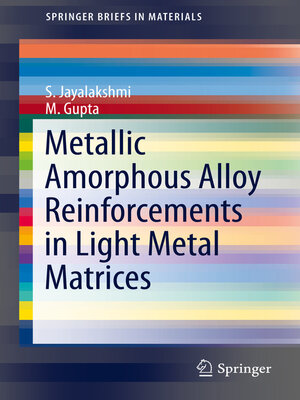Metallic Amorphous Alloy Reinforcements in Light Metal Matrices
ebook ∣ SpringerBriefs in Materials
By S. Jayalakshmi

Sign up to save your library
With an OverDrive account, you can save your favorite libraries for at-a-glance information about availability. Find out more about OverDrive accounts.
Find this title in Libby, the library reading app by OverDrive.



Search for a digital library with this title
Title found at these libraries:
| Library Name | Distance |
|---|---|
| Loading... |
This book presents cutting-edge research on the design and development of novel, advanced high-strength, light-weight materials via the incorporation of novel reinforcements, namely, metallic amorphous alloys/bulk metallic glasses (BMG), in light metal matrix composites (LMMCs) based on Al and Mg. The book begins with an introduction to conventional ceramic reinforced light metal matrix composites, along with the major drawbacks which limit their application. Metallic amorphous alloys/Bulk Metallic Glasses (BMG) are new class of metallic materials that are distinctly differently from conventional metals/alloys in terms of their structure and thermal behavior, and exhibit extremely high strength (1 to 2 GPa) and large elastic strain limit (1 to 2%). Given these unique properties, upon their incorporation into Al/Mg-matrices, they provide superior interfacial properties, i.e. high degree of compatibility with the matrix due to their metallic nature when compared to conventional ceramic reinforcements, and thereby significantly enhance the mechanical performance of LMMCs. Amorphous/BMG reinforced LMMCs is an emerging research field and the existing literature is meager. This book discusses the various processing methods that would be suitable for these novel materials. A comparison of mechanical properties and strengthening mechanisms of amorphous/BMG reinforced composites with those of conventional ceramic composites is presented. Future research directions and wider research potential of the novel materials are discussed, and prospective applications are highlighted. For ease of understanding and comparison, appropriate schematics, tables, and figures are provided.







